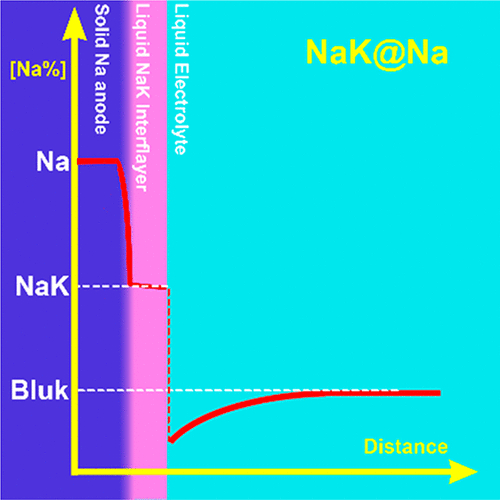当前位置:
X-MOL 学术
›
J. Phys. Chem. Lett.
›
论文详情
Our official English website, www.x-mol.net, welcomes your
feedback! (Note: you will need to create a separate account there.)
Liquid Alloying Na–K for Sodium Metal Anodes
The Journal of Physical Chemistry Letters ( IF 4.8 ) Pub Date : 2021-09-20 , DOI: 10.1021/acs.jpclett.1c02248 Cheng Liu 1 , Hongyi Chen 1 , Wentao Deng 1 , Jun Chen 1 , Ye Tian 1 , Xu Gao 1 , Xinglan Deng 1 , Shouyi Yi 1 , Shuo Li 1 , Libao Chen 1 , Anqiang Pan 2 , Jianmin Ma 3 , Hongsuai Hou 1 , Guoqiang Zou 1 , Debbie S Silvester 4 , Xiaobo Ji 1
The Journal of Physical Chemistry Letters ( IF 4.8 ) Pub Date : 2021-09-20 , DOI: 10.1021/acs.jpclett.1c02248 Cheng Liu 1 , Hongyi Chen 1 , Wentao Deng 1 , Jun Chen 1 , Ye Tian 1 , Xu Gao 1 , Xinglan Deng 1 , Shouyi Yi 1 , Shuo Li 1 , Libao Chen 1 , Anqiang Pan 2 , Jianmin Ma 3 , Hongsuai Hou 1 , Guoqiang Zou 1 , Debbie S Silvester 4 , Xiaobo Ji 1
Affiliation

|
The prospects of sodium (Na) metal batteries have been fatally plagued by interfacial Na dendrites, mainly affected by preferred nucleation on the metal anode and the steep gradient of Na ions in the electrolyte, leading to limited Coulombic efficiency and short lifespans. Herein, an electrochemically inert potassium-based Na–K alloy demonstrates a liquid alloying diffusion mechanism that enables dendrite-free Na anodes. The extremely small Na fluctuation and flexible Na–K bonds in the liquid alloy phase bring isotropic nucleation of Na upon electroplating/stripping, which is directly observed by in situ optical imaging. Spontaneously, serving as (de)sodiation buffer with faster electron/mass transportation, the liquid inertia also provides attenuated concentration distribution of Na. Significantly, a record capacity retention of approximately 100% is rendered when coupled with Na3V2(PO4)3 cathodes (ca. 2 mg cm–2) over 500 cycles at 10C, advancing the possibility of using liquid alloy for stable metal anodes beyond Na storage systems.
中文翻译:

用于钠金属阳极的液态合金化钠钾
钠(Na)金属电池的前景受到界面钠枝晶的致命困扰,主要受金属负极上的优先成核和电解质中钠离子的陡峭梯度的影响,导致库仑效率有限和寿命短。在此,电化学惰性钾基钠钾合金展示了一种液体合金化扩散机制,可实现无枝晶钠阳极。液态合金相中极小的 Na 波动和灵活的 Na-K 键导致电镀/剥离时 Na 的各向同性成核,这是通过原位直接观察到的光学成像。自发地,作为具有更快电子/质量传输的(脱)钠缓冲液,液体惯性也提供了 Na 的衰减浓度分布。值得注意的是,当与 Na 3 V 2 (PO 4 ) 3阴极(约2 mg cm –2)在 10 C 下循环超过 500 次时,容量保持率约为 100% ,从而提高了使用液态合金稳定的可能性。钠存储系统以外的金属阳极。
更新日期:2021-09-30
中文翻译:

用于钠金属阳极的液态合金化钠钾
钠(Na)金属电池的前景受到界面钠枝晶的致命困扰,主要受金属负极上的优先成核和电解质中钠离子的陡峭梯度的影响,导致库仑效率有限和寿命短。在此,电化学惰性钾基钠钾合金展示了一种液体合金化扩散机制,可实现无枝晶钠阳极。液态合金相中极小的 Na 波动和灵活的 Na-K 键导致电镀/剥离时 Na 的各向同性成核,这是通过原位直接观察到的光学成像。自发地,作为具有更快电子/质量传输的(脱)钠缓冲液,液体惯性也提供了 Na 的衰减浓度分布。值得注意的是,当与 Na 3 V 2 (PO 4 ) 3阴极(约2 mg cm –2)在 10 C 下循环超过 500 次时,容量保持率约为 100% ,从而提高了使用液态合金稳定的可能性。钠存储系统以外的金属阳极。











































 京公网安备 11010802027423号
京公网安备 11010802027423号